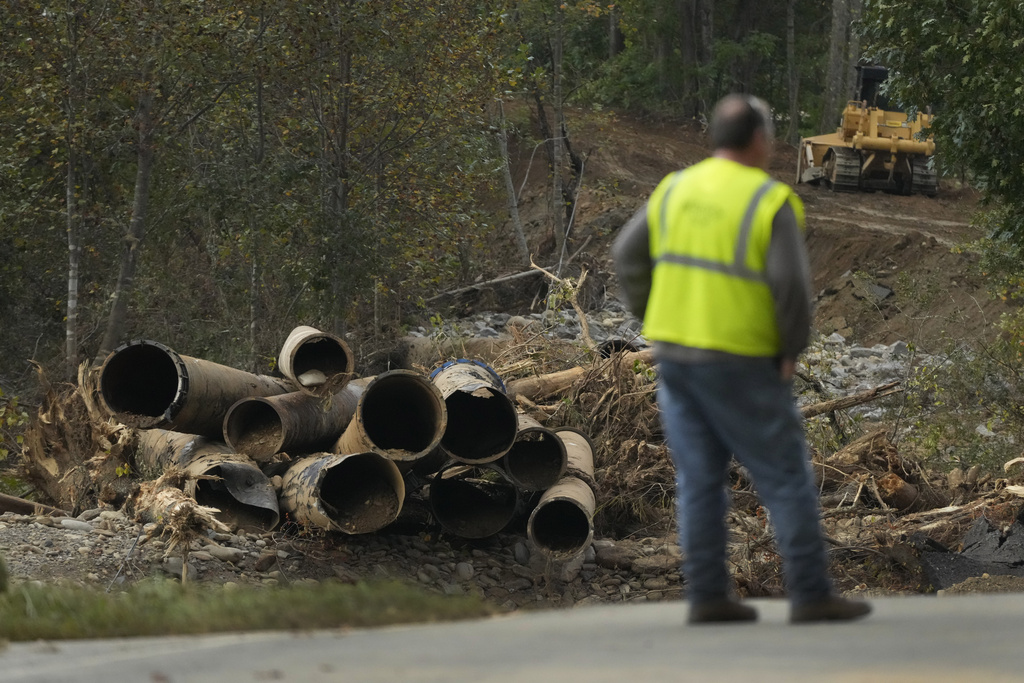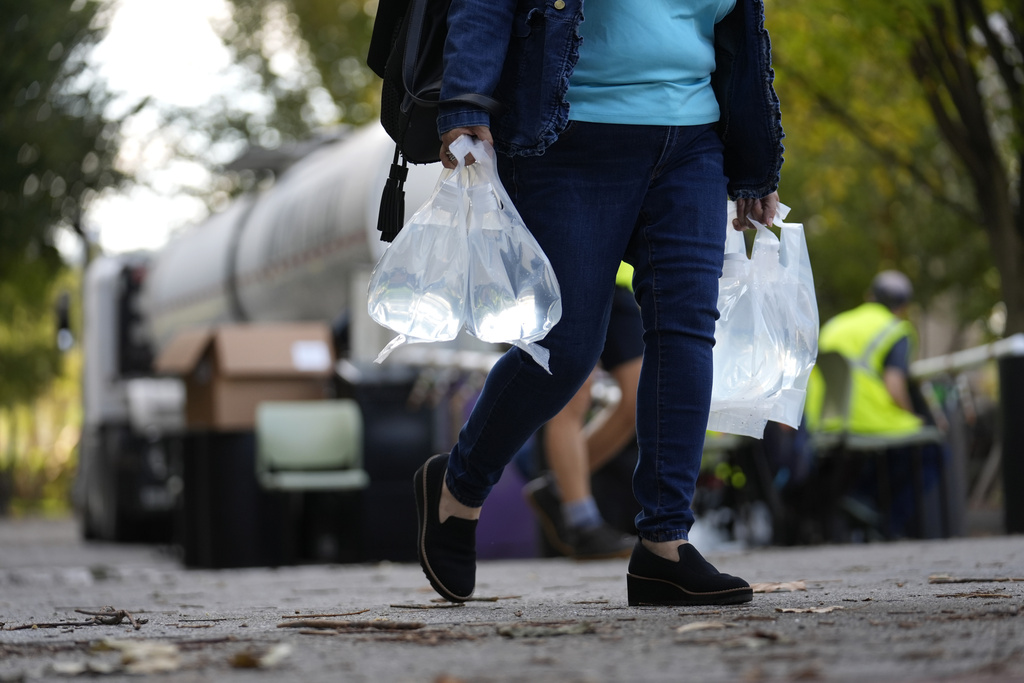NC Struggles with Water Crisis After Helene’s Devastation \ Newslooks \ Washington DC \ Mary Sidiqi \ Evening Edition \ Nearly a week after Hurricane Helene struck western North Carolina, residents face a severe water crisis due to widespread damage to Asheville’s water infrastructure. Flooding destroyed key parts of the system, and recovery may take weeks. Meanwhile, residents are adapting, relying on tanker trucks for drinking water and finding creative ways to meet basic needs amidst the ongoing disruption.

Hurricane Helene’s Aftermath in Asheville: Quick Looks
- Water Crisis: Asheville’s water system severely damaged; residents rely on tanker trucks for drinking water.
- Devastating Flooding: Flooding has damaged crucial infrastructure, leaving repairs projected to last for weeks.
- Limited Power and Water: About 62% of homes have power restored, but water remains scarce.
- Health Concerns: Lack of running water and overflowing toilets pose public health risks.
- Community Resilience: Residents like Travis Edwards are developing creative methods to ration and reuse water as infrastructure slowly recovers.
Deep Look
Nearly a week after Hurricane Helene caused severe devastation across western North Carolina, Asheville residents are grappling with a critical scarcity of drinking water and a long road to recovery. The damage has been profound, with flooding that tore through infrastructure, disabling much of Asheville’s water system and leaving officials predicting weeks before full repairs are completed.
On Wednesday, residents gathered in downtown Asheville with buckets, milk jugs, and 5-gallon containers to collect drinking water from a shiny stainless steel tanker truck—a temporary but essential solution amid the water crisis. Anna Ramsey, along with her two children, left the site carrying plastic bags filled with 2 gallons of water each. “We have no water. We have no power. But I think it’s also been humbling,” said Ramsey, reflecting the resilience of the community.
Severe Infrastructure Damage and Water Shortage
Hurricane Helene’s impact across the Southeast has been catastrophic, with power outages so widespread that parts of the region were visibly dark from space. With tens of trillions of gallons of rain falling, the storm took the lives of more than 200 people, making it the deadliest hurricane to hit the mainland U.S. since Katrina in 2005. Hundreds remain unaccounted for as search crews wade through knee-deep debris, still searching for residents.
The damage inflicted on the water utilities across inland areas is so extensive that one federal official described the toll as “unprecedented.” According to the Environmental Protection Agency (EPA), as of Thursday, around 136,000 people in the Southeast were being served by nonoperational water providers, while more than 1.8 million individuals were under a boil water advisory.
Western North Carolina, particularly Asheville, was especially hard hit. With so much of the region’s infrastructure compromised, the steep, narrow valleys of the Blue Ridge Mountains—usually a bustling tourist attraction in October—present additional challenges to restoration efforts. Brian Smith, acting deputy division director for the EPA’s Southeast water division, highlighted the difficulties of operating in such terrain, stating, “The challenges of the geography are just fewer roads, fewer access points, fewer areas of flat ground to stage resources.”
Life Without Water and Power
The need for running water has become a daily struggle for residents. “I would love a shower,” said Asheville resident Sue Riles, summing up what many felt after days without running water. The floodwaters destroyed critical parts of Asheville’s water system, including the pipes transporting water from a mountain reservoir—the largest of the city’s three main water sources. A second reservoir was also knocked offline, and access had to be restored by rebuilding a destroyed road.
Although a third water source has been brought back online, restoring some flow to parts of southern Asheville, the full recovery is far from complete. Without comprehensive repairs, schools remain closed, hospitals cannot resume normal operations, and businesses like hotels and restaurants struggle to reopen.
Even non-potable water is in short supply. Drew Reisinger, Buncombe County’s register of deeds, expressed his concern for residents living in apartments who have no easy way of collecting water to flush their toilets. He emphasized the public health risk posed by the lack of sanitation facilities: “One thing no one is talking about is the amount of poop that exists in every toilet in Asheville. We’re dealing with a public health emergency.”
Health and Safety Concerns Amid the Crisis
The longer the water crisis persists, the more dangerous it becomes. Even in communities fortunate enough to still have running water, over 1.8 million people are under boil water advisories, indicating the risk of contamination. Boiling water for drinking and cooking is both time-consuming and carries the risk of improper sanitization, potentially leading to illness. Natalie Exum, an assistant professor at Johns Hopkins Bloomberg School of Public Health, noted, “Every day that goes by, you could be exposed to a pathogen. These basic services that we take for granted in our everyday lives actually do do a lot to prevent illness.”
Residents like Travis Edwards experienced the shortage firsthand. He described how he initially collected as much water as he could after the storm but saw the supply quickly dwindle. With no running water, Edwards and his child were forced to ration their supply, resorting to hand sanitizer and using minimal amounts on their toothbrushes. “We didn’t realize how dehydrated we were getting,” he admitted.
Rebuilding Amid Ongoing Challenges
Federal relief efforts are underway, with millions of gallons of water shipped to impacted areas, though many residents still face challenges due to power outages and lack of cell service. As of Thursday, about 62% of homes and businesses had power restored, while 8,000 crews were working around the clock to restore service in the hardest-hit parts of North Carolina. In ten counties, however, approximately half of the cell service infrastructure remained down, complicating recovery efforts further.
One of the immediate challenges for water utilities is assessing the extent of damage to their systems—a task that, in severe cases, may require EPA expertise. Water pipes, often buried under roads, have suffered substantial damage, and many roads were left twisted and crumpled by the floodwaters. “Pretty much anytime you see a major road damaged, there’s a very good chance that there’s a pipe in there that’s also gotten damaged,” explained Mark White, a drinking water global practice leader at the engineering firm CDM Smith.
Generally, repairs start at the water treatment plants and extend outward, starting with the largest pipes closest to the plant. “Over time, you’ll gradually get water to more and more people,” said White.
Compounding the problem is the emotional toll on recovery teams. While search and rescue operations continue, water repair workers often find themselves working around these missions. Kevin Morley, manager of federal relations for the American Water Works Association, noted the mental strain on these teams. “There’s emotional support that is really important for all the people involved. You’re seeing people’s lives just wiped out.”
Looking Ahead: Building Resilience
Even residents with private wells are not immune. Well pumps have lost power, and floodwaters have contaminated private water supplies, further exacerbating the crisis. Craig Colten, a retired professor with expertise in resilience to extreme weather, hopes that the devastation left by Hurricane Helene will serve as a wake-up call for politicians to invest more in resilient infrastructure. “There’s often a ‘blind faith’ assumption that drinking water won’t fail,” Colten noted, emphasizing that the current technology was not sufficient to withstand the storm.
Erik Olson, a health and food expert with the Natural Resources Defense Council, echoed this sentiment. He warned that climate change is likely to increase the frequency and intensity of such extreme weather events. “I think states and the federal government really need to step back and start looking at how we’re going to prepare for these extreme weather events that are going to be occurring and recurring every single year,” Olson said.
Community Adapting to New Realities
In the meantime, Asheville residents are finding creative ways to adapt to the ongoing crisis. Travis Edwards has developed a system for conserving water by using a bleach mixture to wash dishes and then reusing that water for flushing the toilet. With power and cell service gradually returning and water distribution sites providing much-needed supplies, Edwards is finally feeling a sense of hope. “To not feel guilty about using more than a cup of water to, like, wash yourself … I’m really, really grateful,” he said.
The road to recovery in Asheville and western North Carolina is long, and full restoration will require both time and significant resources. In the face of such immense challenges, residents continue to demonstrate resilience, adapting to a reality where basic resources like water are precious and, for now, hard to come by.
NC Struggles with NC Struggles with NC Struggles with NC Struggles with NC Struggles with







